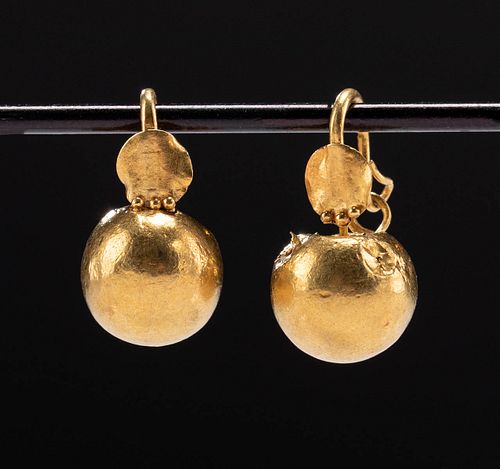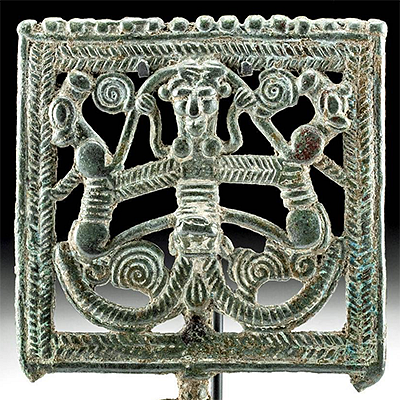Roman Gold Earrings - Ball / Bulla Forms
Lot 21
About Seller
Artemis Gallery
686 S Taylor Ave, Ste 106
Louisville, CO 80027
United States
Selling antiquities, ancient and ethnographic art online since 1993, Artemis Gallery specializes in Classical Antiquities (Egyptian, Greek, Roman, Near Eastern), Asian, Pre-Columbian, African / Tribal / Oceanographic art. Our extensive inventory includes pottery, stone, metal, wood, glass and textil...Read more
Categories
Estimate:
$1,000 - $1,500
Absentee vs Live bid
Two ways to bid:
- Leave a max absentee bid and the platform will bid on your behalf up to your maximum bid during the live auction.
- Bid live during the auction and your bids will be submitted real-time to the auctioneer.
Bid Increments
| Price | Bid Increment |
|---|---|
| $0 | $25 |
| $300 | $50 |
| $1,000 | $100 |
| $2,000 | $250 |
| $5,000 | $500 |
| $10,000 | $1,000 |
| $20,000 | $2,500 |
| $50,000 | $5,000 |
| $100,000 | $10,000 |
| $200,000 | $20,000 |
About Auction
By Artemis Gallery
Nov 5, 2020
Set Reminder
2020-11-05 10:00:00
2020-11-05 10:00:00
America/New_York
Bidsquare
Bidsquare : Ancient & Ethnographic From Around the World
https://www.bidsquare.com/auctions/artemis-gallery/ancient-ethnographic-from-around-the-world-5916
Ancient art from Egypt, Greece, Italy and the Near East, as well as Asian, Pre-Columbian, Native American, African / Tribal / Oceanic, Spanish Colonial, Russian Icons, Fine art, much more! All categories, all price ranges... all legally acquired and guaranteed to be as described or your money back. Artemis Gallery info@artemisgallery.com
Ancient art from Egypt, Greece, Italy and the Near East, as well as Asian, Pre-Columbian, Native American, African / Tribal / Oceanic, Spanish Colonial, Russian Icons, Fine art, much more! All categories, all price ranges... all legally acquired and guaranteed to be as described or your money back. Artemis Gallery info@artemisgallery.com
- Lot Description
Roman, Imperial Period, ca. 1st to 3rd century CE. A matching pair of 92% gold (equivalent to 22K+) earrings, each one presenting a ball-like form that some might call a bulla, with granules followed by a petite shield attached to the ear wires above. Interestingly, baby boys were traditionally gifted with a gold bulla (meaning ball) to hang around their necks. The bulla pendant was believed to be a protective amulet that could ward off evil spirits and guard their status as free children. The Romans adopted this practice from the Etruscans, as both the Romans and he Etruscans believed that children were vulnerable beings who needed protection. Upon reaching adulthood, a man would then offer his bulla to a god as a gesture of gratitude for protecting him. In this spirit, these earrings, resembling bullas, were probably intended to offer the wearer protection as well. This type of earring was often depicted on mummy portraits dating to the Julio-Claudian and Flavian periods. Gold quality: 92%, equivalent to 22K+. Weight: 4.6 grams. Size: .8" L x .375" in diameter (2 cm x 1 cm)
According to the Johns Hopkins Archaeological Museum, "Freeborn Roman male children wore bullae until they reached adulthood. In ancient Rome, a boy would receive a bulla eight days after his birth on the same day that he was given his name. This important festival marked the child’s acceptance into the family. It is possible that Roman boys wore their bullae only when they were outside their homes, at occasions when they would have been in contact with people beyond their kin group. In addition to their bullae, Roman boys also wore the toga praetexta – a garment decorated with a broad purple stripe that was also worn by Roman magistrates. Together, the bulla and the toga praetexta visually declared a child’s status as a free Roman citizen."
See a Roman gold earring in the shape of a bulla from the excavations of Pompeii, Campania, Italy, ca. 1st century. Naples, Museo Archeologico Nazionale (Archaeological Museum).
See a floor mosaic from Pompeii featuring a portrait of a female who is wearing similar bullae earrings, ca. 1st Century. Naples, Museo Archeologico Nazionale (Archaeological Museum).
Provenance: ex Estate of Eldert Bontekoe, Pegasi Numismatics, Ann Arbor, Michigan USA acquired before 2000
All items legal to buy/sell under U.S. Statute covering cultural patrimony Code 2600, CHAPTER 14, and are guaranteed to be as described or your money back.
A Certificate of Authenticity will accompany all winning bids.
We ship worldwide and handle all shipping in-house for your convenience.
#158903One earring shows significant indentations, particularly to the back of its form, starting at the top of the sphere between the shield and the wire to the bottom. The shield shows expected bending/indentations and the wire has fused with the sphere. The other earring also shows indentations and a couple of punctures to the sphere; the attachment point between the shield/wire and the front end of the sphere has separated. Ear wires are not functional.Condition
- Shipping Info
-
All shipping is handled in-house for your convenience. Your invoice from Artemis Gallery will include shipping calculation instructions. If in doubt, please inquire BEFORE bidding for estimated shipping costs for individual items.
-
- Buyer's Premium



 EUR
EUR CAD
CAD AUD
AUD GBP
GBP MXN
MXN HKD
HKD CNY
CNY MYR
MYR SEK
SEK SGD
SGD CHF
CHF THB
THB














